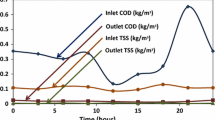Abstract
Efficient treatment, optimization and reduction in corrosion of sewage pipe networks are crucial for water resources engineering works and environmental experts. This paper revealed treatment optimization and performance evaluation of water supply schemes using Akure and Environs as a case study. Laboratory analysis of the properties of raw and treated water was compared with World Health Organization standard for safe drinking water. A regression model using Minitab and an optimized model using Microsoft Excel method were used. A suitable model and cost estimates were also developed for the optimization of both plants. Discussion of the problems faced with water production in the Ondo and Igbara-Oke plants in Nigeria and the cost estimates of the solutions proffered were done. The adoption and implementation of these solutions for the treatment plants will assist the government maintenance policies on sustainable water supply and optimization for other treatment plants. Training, development and capacity building for sustainable water resource management is very crucial in Nigeria. More research should be funded and carried out along this direction.










Similar content being viewed by others
References
Adsera A, Boix C, Payne M (2003) Are you being served? Political accountability and the quality of government. J Law Econ Organ 19(2):445–490
Ashley R, Briefing NG (2009) Semple’s ‘principles of environmental protection’. Proc ICE Eng Sustain 162(1):3–11
Davis J (2004) Corruption in public service delivery: experience from South Asia’s water and sanitation sector. World Dev 32(1):53–71
Deininger K, Mpuga P (2005) Does greater accountability improve the quality of public service delivery? Evidence from Uganda. World Dev 33(1):171–191
Farhaouil L, Mustapha D (2016) Optimization of drinking water treatment process by modeling the aluminum sulfate dose. Br J Appl Sci Technol 17(1):1–14
Gardels D (2011). Economic input–output life cycle assessment of water reuse strategies in residential buildings and communities. MSc. thesis. University of Nebraska e Lincoln, Nebraska, USA
Glick S, Guggemos AA (2013) Rethinking wastewater-treatment infrastructure: case study using life-cycle cost and life-cycle assessment to highlight sustainability considerations. J Constr Eng Manag 139(12):A5013002
Hepburn C (2010) Environmental policy, government, and the market. Oxford Rev Econ Policy 26(2):117–136
Lemos D, Dias AC, Gabarrell X, Arroja L (2013) Environmental assessment of an urban water system. J Clean Prod 54:157–165
Martínez-Paz JM, Pellicer-Martínez F, Colino J (2014) A probabilistic approach for the socioeconomic assessment of urban river rehabilitation projects. Land Use Policy 36:468–477
Matos C, Pereira S, Amorim EV, Bentes I, Briga-Sa A (2014) Wastewater and greywater reuse on irrigation in centralized and decentralized systems as an integrated approach on water quality, energy consumption and CO2 emissions. Sci Total Environ 493:463–471
Oyebode OJ, Adebanjo AS, Nd-Ezumah (2019) Conditions of available sources of water for domestic use in selected communities in Ado-Ekiti, Ekiti State, Nigeria. Afr J Environ Sci Technol 13(2):84–90. https://doi.org/10.5897/AJEST2018.2509
Pedro-Monzonís M, Solera A, Ferrer J, Estrela T, Paredes-Arquiola J (2015) A review of water scarcity and drought indexes in water resources planning and management. J Hydrol 527:482–493
Pophare AM, Lamsoge BR, Katpatal YB, Nawale VP (2014) Impact of over-exploitation on subwater quality: a case study from WR-2 watershed, India. J Earth Syst 123:1541
Przeworski A, Stokes S, Manin B (1999) Democracy, accountability and representation. Cambridge University Press, New York
Reinikka R, Svensson J (2005) Fighting corruption to improve schooling: evidence from a newspaper campaign in Uganda. J Eur Econ Assoc 3(2–3):259–267
Rijsberman FR (2006) Water scarcity: Fact or fiction? Agric Water Manag 80:5–22
Sandoval-Solis S, McKinney D, Loucks D (2011a) Sustainability index for water resources planning and management. J Water Resour Plan Manag 137:381–390
Sandoval-Solis S, McKinney D, Loucks D (2011b) Sustainability index for water resources planning and management. J Water Resour Plan Manag 123:1541–1566
Shehabi A, Stokes JR, Horvath A (2012) Energy and air emission implications of a decentralized wastewater system. Environ Res Lett 7:2
Thibodeau C, Monette F, Bulle C, Glaus M (2014) Comparison of black water source-separation and conventional sanitation systems using life cycle assessment. J Clean Prod 67:45–57
United Nations (2010) United Nations resolution 64/292 the human right to water and sanitation. www.un.org. Accessed 20 June 2018
Wissel S, Watzold F (2010) A conceptual analysis of the application of tradable permits to biodiversity conservation. Conserv Biol 24(2):404–411
World Bank (2013) WB confronts US$260 billion a year in global economic losses from lack of sanitation. http://www.worldbank.org/en/news/press-release/2013/04/19/wb-confrontsus-260-billion-a-year-in-global-economic-losses-from-lack-of-sanitation. Accessed 22 July 2013
Acknowledgements
We appreciate copious individuals and institutions that have contributed to this research work.
Author information
Authors and Affiliations
Corresponding author
Additional information
Editorial responsibility: J Aravind, M.Tech.
Rights and permissions
About this article
Cite this article
Oyebode, O.J., Omoya, O.O. Treatment optimization and performance evaluation of water supply schemes: a case study on Akure and Environs. Int. J. Environ. Sci. Technol. 16, 6873–6884 (2019). https://doi.org/10.1007/s13762-019-02276-9
Received:
Revised:
Accepted:
Published:
Issue Date:
DOI: https://doi.org/10.1007/s13762-019-02276-9




